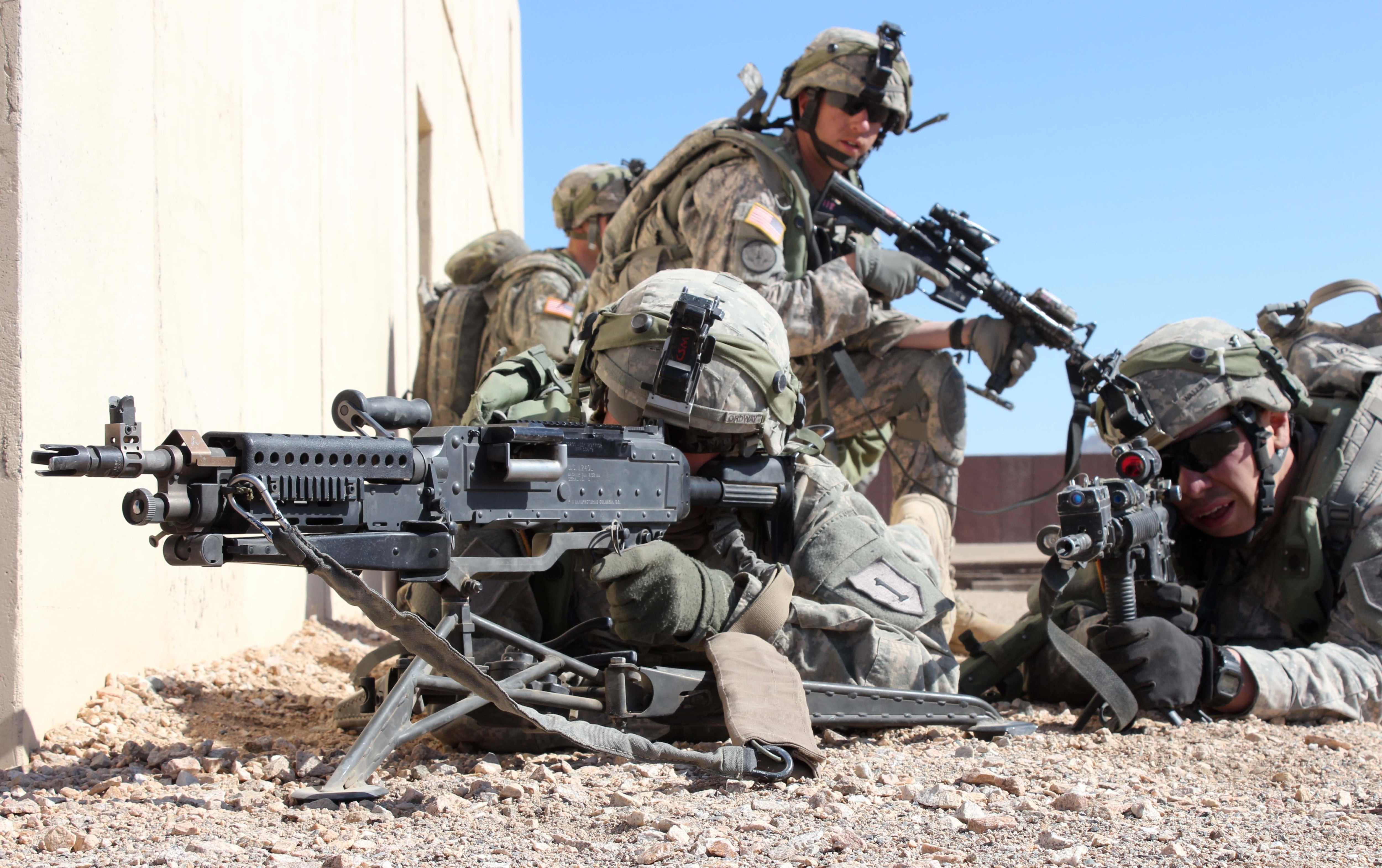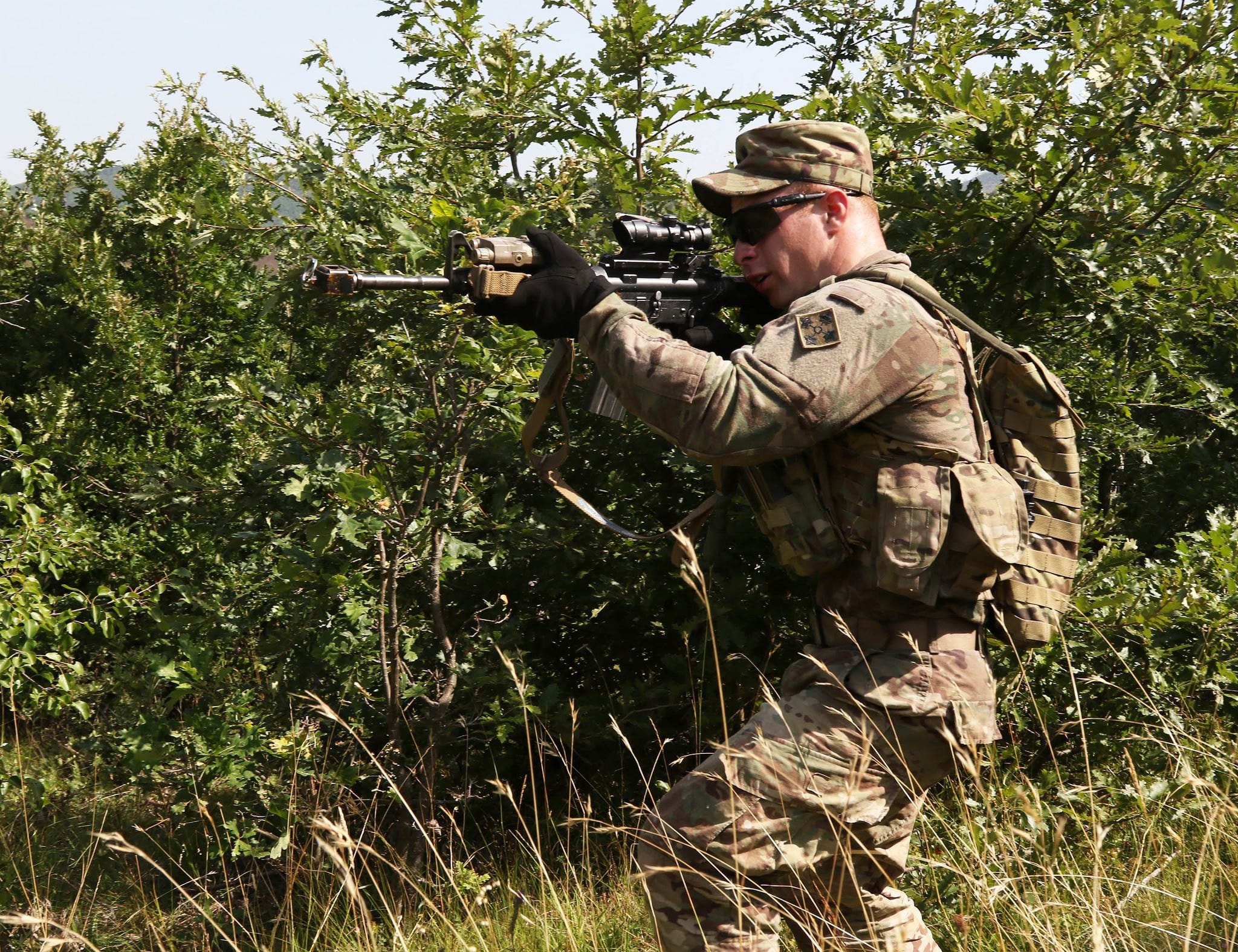After carrying the M16 or one of its cousins across the globe for more than half a century, soldiers could get a peek at a new prototype assault rifle that fires a larger round by 2020.
Army researchers are testing half a dozen ammunition variants in "intermediate calibers," which falls between the current 7.62 mm and 5.56 mm rounds, to create a new light machine gun and inform the next-generation individual assault rifle/round combo.
The weapon designs being tested will be "unconventional," officials said, and likely not one that is currently commercially available.
Some intermediate calibers being tested include the .260 Remington, 6.5 Creedmoor, .264 USA as well as other non-commercial intermediate calibers, including cased telescoped ammo, Army officials said.
If selected by senior leaders, the weapon could resolve a close-quarters weapons debate about calibers that critics say dates to the 1920s and has influenced military small arms ever since.
If successful, the new rifle and round combination would give troops a weapon they can carry with about the same number of rounds as the current 5.56 mm but with greater range and accuracy in their firepower — with little change in weight.
The new rifle would likely replace the M16/M4 platform, which has been in the hands of troops since the 1960s and undergone multiple modifications and upgrades.
Maj. Jason Bohannon, lethality branch chief at the Army's Maneuver Center of Excellence at Fort Benning, Georgia, and Matt Walker, deputy director of the branch and a retired command sergeant major, spoke recently to Army Times about broad efforts in small arms weapons research and development.
'Better option'
Work on the new round began in recent years, Bohannon said, and much of the next steps in developing both the round and rifle will be driven by the Small Arms Ammunition Configuration study.
The study has been going on since at least 2014, according to the Army.
The study is expected to conclude in the next three months, Walker said.
Portions of that report and its findings will likely be made public, but other portions may be deemed sensitive, they said.
Multiple active and retired military arms advocates and industry experts have presented papers and data on the alleged "overmatch" that U.S. troops face on the battlefield with their current calibers.
One oft-noted recent study was authored by then-Army Maj. Thomas Ehrhart, who wrote a 2009 paper titled, "Increasing Small Arms Lethality in Afghanistan: Taking back the Infantry Half-Kilometer."
The paper drew from soldiers' experience in Afghanistan firefights.
Ehrhart wrote that half of the firefights infantry units in Afghanistan encountered were past 300 meters, and the 5.56 mm round had lessened lethality at longer distances.
He offered two solutions — a more effective 5.56 mm round, or the "better option" of adopting a caliber in the 6.5 mm to 7 mm range.
The major then cited a 2006 study by the Joint Service Wound Ballistics–Integrated Product Team, which also named the ideal caliber in the 6.5 mm to 7 mm size.

Soldiers from 2nd Brigade Combat Team, 1st Infantry Division, pull security during an exercise at the National Training Center, Fort Irwin, Calif. Army officials said they're developing new weapons systems to give soldiers, especially at the squad and platoon levels, as much firepower as possible.
Photo Credit: Sgt. Eric M. Garland/Army
Decades-old debate
This isn’t the first time ammunition experts have reached that conclusion.
"There is a long-running debate, going back almost 100 years now, about the optimal, optimum small arm," said retired Maj. Gen. Robert Scales, author of the 2016 book "Scales on War: The Future of America’s Military at Risk."
Scales pointed to the development of the M1 rifle by John Garand in the 1920s.
At the time, Garand built both a .30 caliber and a .276 caliber version of the rifle.
But a surplus of .30 caliber ammunition from World War I, coupled later with the financial constraints of the Great Depression, led to senior defense officials and political leaders calling for a .30 caliber rifle.
The M1’s design eventually evolved into the M14. Both rifles share a 7.62 mm or .30 caliber bore. But the M14 was soon discarded when, in the 1960s, Air Force Gen. Curtis LeMay purchased the early version of the M16 for some Air Force units.
The M16 was then adopted across the branches and fielded for service in Vietnam, where troops reported frequent jamming and malfunctions in early versions of the weapon.
One case, detailed in the 2010 book "The Gun," by former Marine and award-winning journalist C.J. Chivers, grabbed national attention during the Vietnam War when Marine 1st Lt. Michael Chervenak wrote an open letter that recounted his company’s experiences with the new rifle jamming in combat.
The letter led to hearings in Congress and, along with other incidents, contributed to decades of controversy, modifications and adaptations, which resulted in the current M4 variants, which continue to have their supporters and critics.
Maj. Thomas Campbell, a spokesman for Army Training and Doctrine Command, provided Army Times with the results of a nine-year, post-deployment survey of 9,000 soldiers conducted by the command.
The survey saw 80 percent of troops rate the M4 as "effective or better."
The survey did not compare the M4 to other weapons, but instead asked the respondents to rate the overall effectiveness of the weapon in the performance of their duties while deployed, Campbell said.
Time to invest
The aging M16/M4 platform is nearing the end of its life cycle, Bohannon said.
"Right now the [M16/M4] platform we have is a workhorse and very effective in the hands of a trained soldier or Marine," he said.
But, Walker at Maneuver Center added, the Army can’t continue to ask more of the weapon system that has been in service for so long.
"Our next investment will likely be in a new operating platform," Bohannon said.

Spc. Timothy Squires, an infantryman assigned to 2nd Brigade Combat Team, 4th Infantry Division, scans his sector of fire during squad-level training in Kosovo.
Photo Credit: Staff Sgt. Thomas Duval/Army
Critics of the M16/M4 and the 5.56 mm round say no matter what has been done to improve the M16 and its subsequent variations, the 5.56 mm round lacks the range and lethality needed in modern firefights.
Some of the concerns Scales said he believes are driving military leaders to finally look at an alternative to the 5.56 mm and the M16/M4 include:
— Improvements in adversaries’ body armor, which make the 5.56 mm less lethal.
— Current adversaries such as the Islamic State terror group and others using bigger rounds with more reach against U.S. troops, creating an overmatch.
— Jamming problems with M16/M4 variants that continue to plague the design.
At the 2016 National Defense Industrial Association Armament Systems Forum, retired Brig. Gen. Dave Grange and Jim Schatz, an Army veteran and weapons expert who has since passed away, each gave presentations calling for a new "intermediate caliber" in the 6.5 mm range.
They also referenced the Russian, Islamic State and al-Qaida advantages with longer-reaching and more lethal weapons, including reports of Russian work on their own 6.5 mm assault rifle.
But, Scales said, one of the problems that led to the .30 caliber being adopted over the 6.5 mm nearly a century ago still remains — an abundance of 5.56 mm ammunition stockpiled across U.S. military commands and NATO, whose nations fire the 5.56 mm and 7.62 mm as part of an ammunition standardization agreement made decades ago.
Other weapons work
Meanwhile, the Army’s Maneuver Center isn’t the only entity looking at new or existing small arms replacements.
Marine Corps Times, a sister publication of Army Times, recently reported the Marines are considering equipping nearly every Marine 0311 infantryman with the M27, which first hit the fleet in large quantities in 2010.
The M27 is seen by experts as superior to the M4 in reliability and increased range. But, at $3,000, it runs three times the cost of an M4 and is still chambered in 5.56 mm.
U.S. Special Operations Command is currently testing a new commercially available sniper rifle using the .260 Remington and 6.5 mm Creedmoor rounds, which "stay supersonic longer, have less wind drift and better terminal performance than 7.62 mm ammunition," said Maj. Aron Hauquitz.
SOCOM is also developing polymer ammunition in 6.5 mm to reduce the weight load.
Current research is showing polymer 6.5 mm reducing weight by one-third from 7.62 mm, reaching nearly the same weight as conventional brass 5.56 mm.
Both regular Army weapons researchers at the Maneuver Center and Marine Corps weapons experts are monitoring the SOCOM testing, officials said.
Textron Systems, a private defense industry company, conducted a caliber study using a specially designed .264 caliber cartridge which they said resulted in "terminal effects greater than 7.62 mm NATO out to 1,200 meters" in both their carbine and machine gun.
Data provided by the company showed the machine gun is 7 pounds lighter than the 7.62 mm M240L with 800 rounds of their lightweight ammunition, lowering the combat load by 27 pounds.
The machine gun is also lighter than the M249 SAW, wrote Paul Shipley, chief engineer of light armaments for the company.
While SOCOM is looking at immediate fixes and off-the-shelf options, Bohannon said that the Maneuver Center and related entities working on weapons issues for the regular Army "invests in more revolutionary, long-term" solutions.
Bohannon said that his team has weekly meetings with officials involved with the Joint Service Small Arms Requirements Integration working group, which includes all the services and SOCOM.
While the Army continues to explore existing intermediate rifle/round combinations, their work is only to provide options for senior leadership to choose and then request funding, Bohannon said.
He did not provide cost estimates or a timeline for the potential replacement.
Todd South has written about crime, courts, government and the military for multiple publications since 2004 and was named a 2014 Pulitzer finalist for a co-written project on witness intimidation. Todd is a Marine veteran of the Iraq War.





